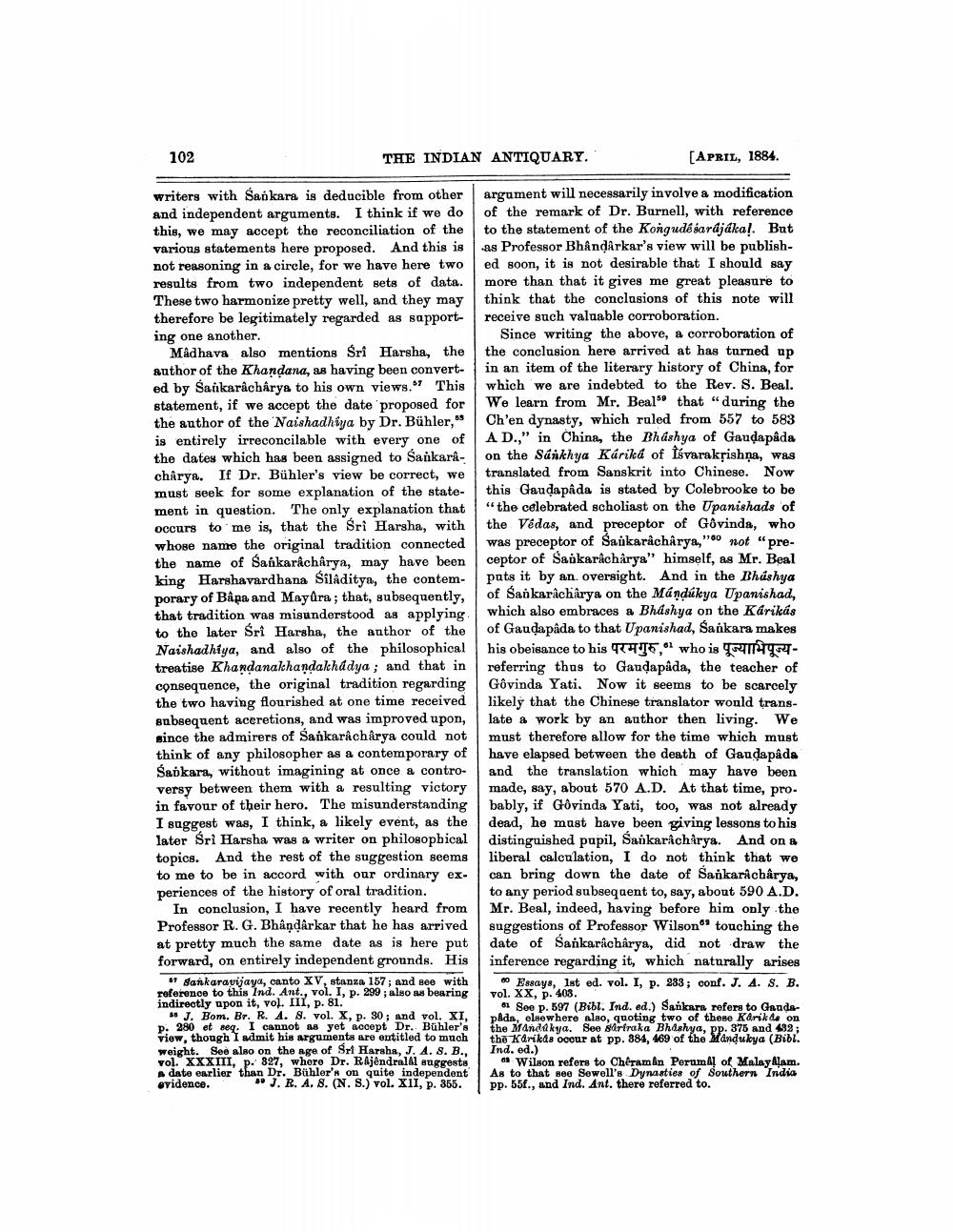________________
102
THE INDIAN ANTIQUARY.
TAPRIL. 1884.
writers with Sankara is deducible from other and independent arguments. I think if we do this, we may accept the reconciliation of the various statements here proposed. And this is not reasoning in a circle, for we have here two results from two independent sets of data. These two harmonize pretty well, and they may therefore be legitimately regarded as supporting one another.
Madhava also mentions Sri Harsha, the author of the Khandana, as having been convert- ed by Saikaracharya to his own views." This statement, if we accept the date proposed for the author of the Naishadhiya by Dr. Bühler," is entirely irreconcilable with every one of the dates which has been assigned to Sankaracharya. If Dr. Bühler's view be correct, we must seek for some explanation of the state ment in question. The only explanation that occurs to me is, that the Sri Harsha, with whose name the original tradition connected the name of Sankaracharya, may have been king Harshavardhana SilAditya, the contemporary of Bapa and Mayura ; that, subsequently, that tradition was misunderstood as applying to the later Sri Harsha, the author of the Naishadhiya, and also of the philosophical treatise Khandanalhandakhadya ; and that in consequence, the original tradition regarding the two having flourished at one time received subsequent accretions, and was improved upon, since the admirers of Sankaracharya could not think of any philosopher as a contemporary of Śavkara, without imagining at once a controversy between them with a resulting victory in favour of their hero. The misunderstanding I suggest was, I think, a likely event, as the later Sri Harsha was a writer on philosophical topics. And the rest of the suggestion seems to me to be in accord with our ordinary experiences of the history of oral tradition.
In conclusion, I have recently heard from Professor R. G. Bhandarkar that he has arrived at pretty much the same date as is here put forward, on entirely independent grounds. His
51 sankaravijaya, canto XV, stanza 157; and see with reference to this Ind. Ant., vol. I, p. 299 ; also as bearing indirectly upon it, vol. III, p. 81.
55 J. Bom. Br. K. A. N. vol. X, P. 80; and vol. XI, D. 280 et seq. I cannot as yet wooopt Dr. Bühler's view. though I admit his arguments are entitled to much weight. See also on the age of Sri Haraha, J. A. 8. B., vol. XXXIII, p. 827, where Dr. Rajendrall suggests A date earlier than Dr. Bühler's on quite independent evidence. "J. R. A. 8. (N. S.) vol. XII, p. 355.
argument will necessarily involve a modification of the remark of Dr. Burnell, with reference to the statement of the Kongude sardjaka!. But -as Professor Bhåndarkar's view will be published soon, it is not desirable that I should say more than that it gives me great pleasure to think that the conclusions of this note will receive such valuable corroboration.
Since writing the above, a corroboration of the conclusion here arrived at has turned up in an item of the literary history of China, for which we are indebted to the Rev. S. Beal. We learn from Mr. Beals that “during the Ch'en dynasty, which ruled from 557 to 583 A D.," in China, the Bhashya of Gaudapâda on the Sankhya Káriká of Išvaraksishņa, was translated from Sanskrit into Chinese. Now this Gauda pada is stated by Colebrooke to be "the celebrated scholiast on the Upanishads of the Vedas, and preceptor of Govinda, who was preceptor of Sankaracharya,"60 not "preceptor of Sankaracharya" himself, as Mr. Beal pats it by an oversight. And in the Bhúshya of Sankaracharya on the Mándúkya Upanishad, which also embraces a Bhashya on the Karikas of Gauda pada to that Upanishad, Sankara makes his obeisance to his परमगुरु, who is पूज्याभिपूज्यreferring thus to Gandapâda, the teacher of Govinda Yati. Now it seems to be scarcely likely that the Chinese translator would translate a work by an author then living. We must therefore allow for the time which must have elapsed between the death of Gandapada and the translation which may have been made, say, about 570 A.D. At that time, pro. bably, if Govinda Yati, too, was not already dead, he must have been giving lessons to his distinguished pupil, Sankaracharya. And on a liberal calculation, I do not think that we can bring down the date of Sankaracharya, to any period subsequent to, say, about 590 A.D. Mr. Beal, indeed, having before him only the suggestions of Professor Wilson touching the date of Sankaracharya, did not draw the inference regarding it, which naturally arises
Essays, Ist ed. vol. I, p. 233; conf. J. 4. S. B. vol. XX, p. 403.
1 See p. 597 (Bibl. Ind. ed.) Sankara refers to Gaudapâda, elsewhere also, quoting two of these Karika on the Mandakwa. See sarfraka Bhashya, pp. 375 and 192; the Karikas occur at pp. 384, 469 of the Mandukya (Bibl. Ind. ed.)
Wilson refers to Chéramin Perumal of Malayalam. As to that see Sewell's Dynasties of Southern India pp. 55f., and Ind. Ant. there referred to.




